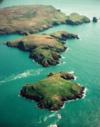
|
Skomer Island Marine Reserve
 Skomer Island, West Wales sa62, United Kingdom Skomer Island, West Wales sa62, United Kingdom
|
Max Depth: Over 150ft/46m
Average Viz: 26-30ft/8-9m
Entry Type: Boat
Bottom Composition: Sand
Aquatic Life: Plenty To See
|
Spring: 50-55°F/10-13°C
Summer: 61-65°F/16-18°C
Fall: 50-55°F/10-13°C
Winter: Under 50°F/10°C
|
|




|
|
Skomer Island Marine Reserve is a boat accessible salt water dive site, located at Skomer Island, West Wales sa62, United Kingdom. The maximum depth is over 150ft/46m. The average visibility is 26-30ft/8-9m.
Skomer Island Marine Reserve in Pembrokeshire, Wales, is a premier location for diving, offering a protected environment with rich marine biodiversity, including diverse reefs, kelp forests, wrecks like the Lucy, and abundant wildlife such as seals, dolphins, and numerous species of fish and invertebrates, making it suitable for divers of all skill levels.
Key aspects of diving in Skomer Island Marine Reserve:
Marine Life:
The reserve is renowned for its thriving marine ecosystem, home to hundreds of species, including over 60 species of nudibranchs, coral, catfish, anemones, and rare seahorses. Grey seals are also abundant, often interacting with divers.
Dive Sites:
Skomer offers a variety of dive sites, from caves and reefs to wrecks and deep wall dives. The "Lucy" wreck, a popular site for advanced divers, is a fully intact wreck at 40m with its superstructure rising to 24m, covered in anemones. The North Wall is a sheer cliff face running down to 45m.
Accessibility and Seasonality:
Diving is possible year-round in Wales for experienced divers with appropriate gear like drysuits, though the main diving months are from April to October when water temperatures and visibility are best. Water temperatures in Pembrokeshire range from 47°F/8°C to 61°F/16°C.
Booking and Logistics:
Boat trips to Skomer Island for diving and landing visits can be booked in advance through Pembrokeshire Islands.
Conservation:
As a marine reserve, Skomer prioritizes the protection of its marine environment, restricting fishing and development to allow marine life to flourish undisturbed.